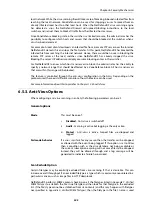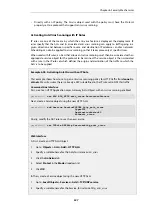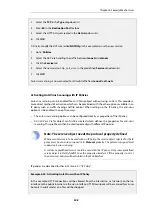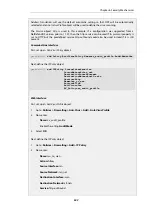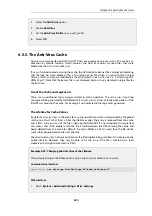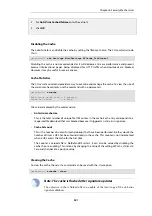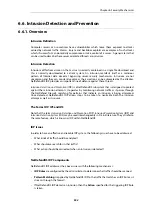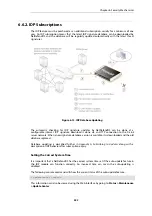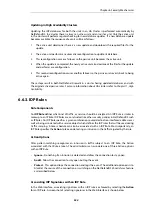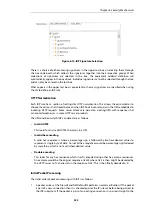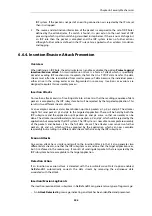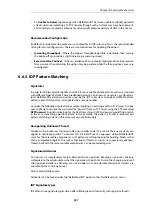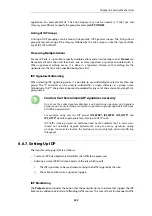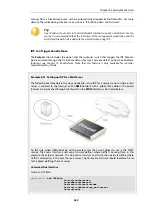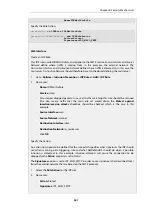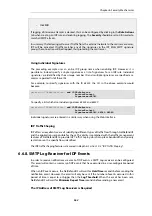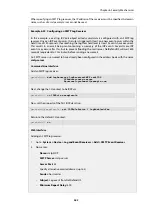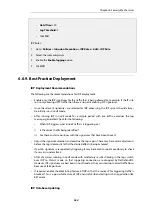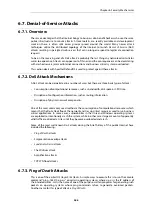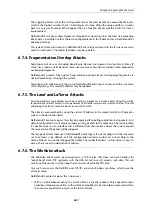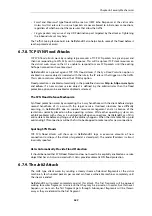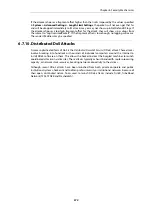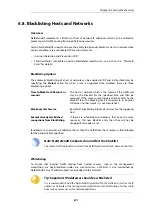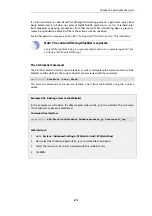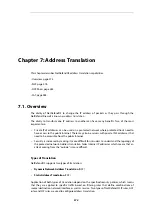
application, for example
MSSQL
. The Sub-Category may not be necessary if the
Type
and
Category
are sufficient to specify the group, for example APP_ITUNES.
Listing of IDP Groups
A listing of IDP groupings can be found in
Appendix B, IDP Signature Groups
. The listing shows
group names consisting of the
Category
followed by the
Sub-Category
, since the
Type
could be
any of IDS, IPS or POLICY.
Processing Multiple Actions
For any IDP rule, it is possible to specify multiple actions and an action type such as Protect can
be repeated. Each action will then have one or more signatures or groups associated with it.
When signature matching occurs it is done in a top-down fashion, with matching for the
signatures for the first action specified being done first.
IDP Signature Wildcarding
When selecting IDP signature groups, it is possible to use wildcarding to select more than one
group. The "?" character can be used to wildcard for a single character in a group name.
Alternatively, the "*" character can be used to wildcard for any set of characters of any length in a
group name.
Caution: Use the minimum IDP signatures necessary
Do not use the entire signature database and avoid using signatures and signature
groups unnecessarily. Instead, use only those signatures or groups applicable to the type
of traffic being protected.
For example, using only the IDP groups
IDS_WEB*
,
IPS_WEB*
,
IDS_HTTP*
and
IPS_HTTP*
would be appropriate for protecting an HTTP server.
IDP traffic scanning creates an additional load on the hardware that, in most cases,
should not noticeably degrade performance. Using too many signatures during
scanning can make the load on the hardware unnecessarily high, adversely affecting
throughput.
6.6.7. Setting Up IDP
The steps for setting up IDP are as follows:
•
Create an
IDP Rule
object which identifies the traffic to be processed.
•
Add one or more
IDP RUle Action
objects to the rule which specify:
i.
The IDP signatures to be used when scanning the traffic targeted by the rule.
ii.
The action to take when a signature triggers.
IDP Blacklisting
The Protect option includes the option that the particular host or network that triggers the IDP
Rule can be added to a
Blacklist
of offending traffic sources. This means that all subsequent traffic
Chapter 6: Security Mechanisms
559
Summary of Contents for NetDefendOS
Page 30: ...Figure 1 3 Packet Flow Schematic Part III Chapter 1 NetDefendOS Overview 30 ...
Page 32: ...Chapter 1 NetDefendOS Overview 32 ...
Page 144: ...Chapter 2 Management and Maintenance 144 ...
Page 284: ...Chapter 3 Fundamentals 284 ...
Page 392: ...Chapter 4 Routing 392 ...
Page 419: ... Host 2001 DB8 1 MAC 00 90 12 13 14 15 5 Click OK Chapter 5 DHCP Services 419 ...
Page 420: ...Chapter 5 DHCP Services 420 ...
Page 573: ...Chapter 6 Security Mechanisms 573 ...
Page 607: ...Chapter 7 Address Translation 607 ...
Page 666: ...Chapter 8 User Authentication 666 ...
Page 775: ...Chapter 9 VPN 775 ...
Page 819: ...Chapter 10 Traffic Management 819 ...
Page 842: ...Chapter 11 High Availability 842 ...
Page 866: ...Default Enabled Chapter 13 Advanced Settings 866 ...
Page 879: ...Chapter 13 Advanced Settings 879 ...

